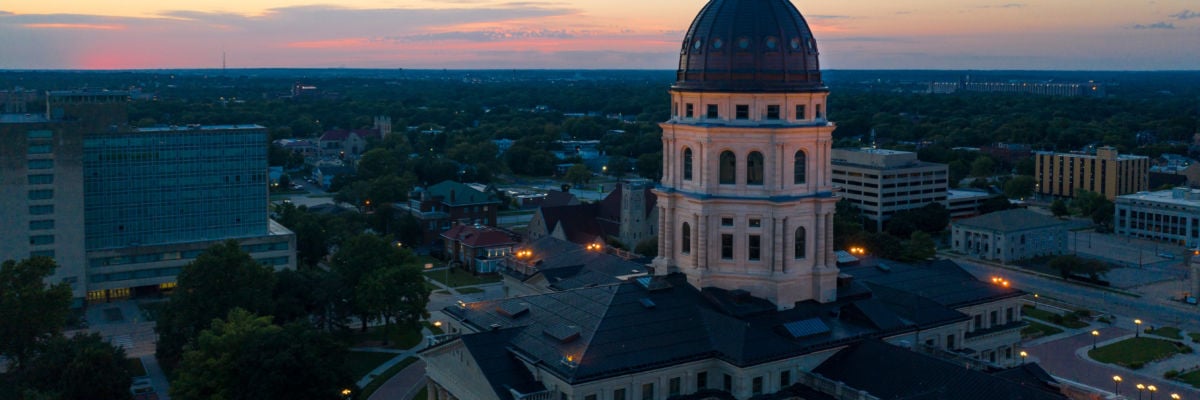
On Friday, March 28, 2025, a small group of self-described Satanists plan to hold a “Black Mass” outside (or inside?) the Kansas Capitol Building in Topeka. The group in question, called the Satanic Grotto, originally were given a permit to hold their blasphemous service within the Capitol, but after a great deal of public outcry, the governor, Laura Kelly, ordered that it be moved outdoors (claiming that the group’s presence would pose a fire hazard). In response, organizer Michael Stewart announced that “the Satanic Grotto’s leadership intends to enter the Capitol Building and perform the ritual under the threat of arrest.”
A few things are worth pointing out. First, this doesn’t appear to be a “real” Black Mass, inasmuch as a Black Mass (allegedly) involves the desecration of the Eucharist. Such a Black Mass had been proposed in Oklahoma in 2014 but was successfully thwarted when the Archdiocese of Oklahoma sued to recover the stolen consecrated host. The Archdiocese of Kansas City in Kansas did the same thing this time, but Michael Stewart (who had previously boasted online that it was a consecrated host) was able to get the lawsuit thrown out by showing a receipt for unconsecrated hosts that he had purchased on Amazon.
Just as their Eucharist appears to be fake, so is their religion. Whereas the term Satanist connotes in the popular imagination dark images of people making offerings to Satan, the reality is that most “Satanists” today are edgelord atheists LARPing as demon-worshipers. That includes Stewart, an atheist who insists that the only two criteria for being a Satanist are that “you’re rebellious” and that “you venerate and identify with Satan in some way.”
This points to the complicated “denominational” system of Satanism, with various groups appropriating Satan for contradictory purposes. On the one hand, there are “theistic Satanists,” like the members of the Temple of Set (a splinter group from the Church of Satan), who literally worship Satan or Set, believing him to be the one true god. But most Satanists are like Stewart: atheists and anti-theists who have seized upon Satan as a symbol of rebellion, or of their political views, or of their desire to shock and mock Christians.
Anton LaVey, founder of the Church of Satan and author of The Satanic Bible, famously described his “religion” as “just Ayn Rand’s philosophy with ceremony and ritual added.” Saul Alinsky, though not a Satanist himself, famously included in his Rules for Radicals a dedication to Lucifer, praising him as “the very first radical.” And the Satanic Temple, founded in 2003 by Lucien Greaves and Malcolm Jarry, says that “to embrace the name Satan is to embrace rational inquiry removed from supernaturalism and archaic tradition-based superstitions.”
By presenting their political agenda as a religion, these Satanists attempt to take advantage of the U.S. Constitution’s protections for religious rights:
The Satanic Temple religiously objects to many of the restrictions that states have enacted that interfere with abortion access as well as other related issues that affect members’ religious rights. TST is taking many steps to address reproductive laws that violate our religious conscience by inflicting guilt and shame in one’s decision and being inconsistent with necessary health and safety standards.
Instead of just calling themselves pro-choice atheists, these atheists present their abortion advocacy as part of their fake religion so that they can claim that their “religious rights” and “religious conscience” are being violated by laws protecting the unborn.
This is very much in the same vein as the Satanic Grotto’s “Satanism.” Michael Stewart was a chapter head for the Satanic Temple, which (again) was founded not out of any authentic religious quest, but as an attempt to make a political point. As The New York Times reported back in 2015,
“The first conception was in response to George W. Bush’s creation of the White House Office of Faith-Based and Community Initiatives,” said Mr. Jarry, who was raised by irreligious Jews. “I thought, ‘There should be some kind of counter.’” He hit on the idea of starting a faith-based organization that met all the Bush administration’s criteria for receiving funds, but was repugnant to them. “Imagine if a Satanic organization applied for funds,” he remembered thinking. “It would sink the whole program.”
Stewart recently explained the idea behind the Kansas Capitol Black Mass this way: “I’ve studied Saul alinsky and community organizing. My goal is to shed light on the religious takeover of our state legislature. I to defy the goveners order even if it means my arrest [sic].”
It is, in fact, difficult to see how either Saul Alinsky or Anton LaVey would approve of the Satanic Grotto’s plan. On community organizing ground, Alinsky argued:
If the real radical finds that having long hair sets up psychological barriers to communication and organization, he cuts his hair. If I were organizing in an orthodox Jewish community I would not walk in there eating a ham sandwich, unless I wanted to be rejected so I could have an excuse to cop out.
To put it mildly, the proposed Black Mass is a good deal more needlessly offensive than the ham sandwich, and intentionally so. The Kansas Legislature responded to the provocation with a House resolution denouncing “the planned satanic worship ritual scheduled to take place on the grounds of the people’s house, the Kansas state capitol grounds, on March 28, 2025, as a despicable, blasphemous and offensive sacrilege to not only Catholics but all people of goodwill.”
Even the Satanist LaVey, who lamented that “no other single device has been associated with Satanism as much as the black mass,” argued that whereas “in the Middle Ages, blaspheming the holy church was shocking,” this is no longer the case. In fact, he conceded that the rebellious thing today wouldn’t be mocking religion, but defending it:
A black mass, today, would consist of the blaspheming of such “sacred” topics as Eastern mysticism, psychiatry, the psychedelic movement, ultra-liberalism, etc. Patriotism would be championed, drugs and their gurus would be defiled, acultural militants would be deified, and the decadence of ecclesiastical theologies might even be given a Satanic boost.
So on either the grounds of political or community organizing or killing sacred cows, this proposed Black Mass seems like a failure. But that’s just the tip of the iceberg: These Satanists don’t really worship Satan, their religion isn’t really a religion, and their “Eucharist” isn’t even consecrated. Instead of devil-worshipers desecrating the Eucharist, their proposed “Black Mass” is just going to be atheists acting rudely toward what both they and we realize is bread.
To be clear, that doesn’t mean that these Renaissance-faire “Satanists” aren’t putting themselves in grave spiritual danger: You can invite the devil in, even if you’re an atheist just doing it to “prove” he doesn’t exist. Plus they’ve promised to desecrate a Bible and a crucifix. So how should we respond to these provocations?
First, by recognizing in this confirmation of the truth of the Mass. As Jesus says, “every kingdom divided against itself is laid waste, and no city or house divided against itself will stand; and if Satan casts out Satan, he is divided against himself; how then will his kingdom stand?” (Matt. 12:25-26). The fact that real and fake Satanists, and the real Satan, hate the Mass so much is strong evidence that it’s of divine origin.
Second, by remembering St. Paul’s admonition from Ephesians 6:11-12:
Put on the whole armor of God, that you may be able to stand against the wiles of the devil. For we are not contending against flesh and blood, but against the principalities, against the powers, against the world rulers of this present darkness, against the spiritual hosts of wickedness in the heavenly places.
Our war is a spiritual one, and our enemies aren’t the “flesh and blood” people who disagree with us, or mock us, or mock our religion. Our enemies are the spiritual forces behind those people. St. Thomas Aquinas, quoting an earlier commentary, put it vividly: “Evil men are horses, and the demons the riders; hence, if we kill the riders, the horses will be ours.” To that end, the best response isn’t to panic, but to pray. In particular, Archbishop Naumann is asking us to “pray for the spiritual conversion of those who promoting and participating in the satanic worship ritual.”



